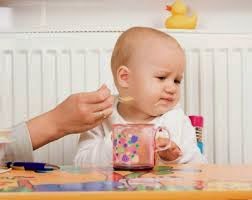 Management of the Patient with Diarrhea
Management of the Patient with Diarrhea A. No Dehydration
- Condition – well, alert
- Mouth and Tongue – moist
- Eyes – normal
- Thirst – drinks normally, not thirsty
- Tears – present
- Skin pinch – goes back quickly
- TREATMENT PLAN A- HOME Treatment.
- Give the child more fluids than usual
- use home fluid such as cereal gruel
- give ORESOL, plain water
- Give the child plenty of food to prevent under nutrition
- continue to breastfeed frequently
- if child is not breastfeed, give usual milk
- if child is less than 6 months and not yet taking solid food, dilute milk for 2 days
- if child is 6 months or older and already taking solid food, give cereal or other starchy food mixed with vegetables, meat or fish; give fresh fruit juice or mashed banana to provide potassium; feed child at least 6 times a day. After diarrhea stops, give an extra meal each day for two weeks.
- Take the child to the health worker if the child does not get better in 3 days or develops any of the following:
- many watery stools
- repeated vomiting
- marked thirst
- eating or drinking poorly
- fever
- blood in the stool
| Age | Amount of ORS to give after each loose stool |
Amount of ORS to provide for use at home
|
| < 24 months | 50-100 ml | 500 ml/day |
| 2-10 years | 100- 200 ml | 1000 ml/day |
| 10 years up | As much as wanted | 2000 ml/day |
- Condition – restless, irritable
- Mouth and Tongue – dry
- Eyes – sunken
- Thirst – thirsty, drinks eagerly
- Tears – absent
- Skin pinch – goes back slowly
- WEIGH PT, TTT. PLAN B
| Age | Weight (kg) | ORS (ml) |
| 4 months | 5 | 200- 400 |
| 4- 11 months | 5- 7.9 | 400- 600 |
| 12-23 months | 8- 10.9 | 600- 800 |
| 2-4 yrs. | 11- 15.9 | 800- 1200 |
| 5-14 yrs. | 16- 29.9 | 1200- 2200 |
| 15 yrs. up | 30 up | 2200- 4000 |
- If the child wants more ORS than shown, give more
- Continue breastfeeding
- For infants below 6 mos. who are not breastfeed, give 100-200 ml clean water during the period
- For a child less than 2 years give a teaspoonful every 1-2 min.
- If the child vomits, wait for 10 min, then continue giving ORS, 1 tbsp/2-3 min
- If the child’s eyelids become puffy, stop ORS, give plain water or breast milk, Resume ORS when puffiness is gone
- If ( -) signs of DHN- shift to Plan A
- Antibiotics should only be used for dysentery and suspected cholera
- Antiparasitic drugs should only be used for amoebiasis and giardiasis
- Condition – lethargic or unconscious; floppy
- Eyes – very sunken and dry
- Tears – absent
- Mouth and tongue – very dry
- Thirst- drinks poorly or not able to drink
- Skin pinch – goes back very slowly
- Treatment PLAN C- treat quickly
- Bring pt. to hospital
- IVF – Lactated Ringers Solution or Normal Saline
- Re-assess pt. Every 1-2 hrs
- Give ORS as soon as the pt. can drink
Role of Breastfeeding in the Control of Diarrheal Diseases Program
Two problems in CDD
- High child mortality due to diarrhea
- High diarrhea incidence among under fives
- Highest incidence in age 6 – 23 months
- Highest mortality in the first 2 years of life
- Main causes of death in diarrhea :
- Dehydration
- To prevent dehydration, give home fluids “am” as soon as diarrhea starts and if dehydration is present, rehydrate early, correctly and effectively by giving ORS
- Malnutrition
- For under nutrition, continue feeding during diarrhea especially breastfeeding.
- breastfeeding
- improved weaning practices
- use of plenty of clean water
- hand washing
- use of latrines
- proper disposal of stools of small children
- measles immunization
1. Risk of severe diarrhea 10-30x higher in bottle fed infants than in breastfed infants.
2. Advantages of breastfeeding in relation to CDD
a. Breast milk is sterile
b. Presence of antibodies protection against diarrhea
c. Intestinal Flora in BF infants prevents growth of diarrhea causing bacteria.
3. Breastfeeding decreases incidence rate by 8-20% and mortality by 24- 27% in infants under 6 months of age.
4. When to wean?
- 4-6 months – soft mashed foods 2x a day
- 6 months – variety of foods 4x a day
Summary of WHO-CDD recommended strategies to prevent diarrhea
1. Improved Nutrition
- Exclusive breastfeeding for the first 4-6 months of life and partially for at least one year.
- Improved weaning practices
- collecting plenty of water from the cleanest source
- protecting water from contamination at the source and in the home
- handwashing
- use of latrines
- proper disposal of stools of young children











.png)















